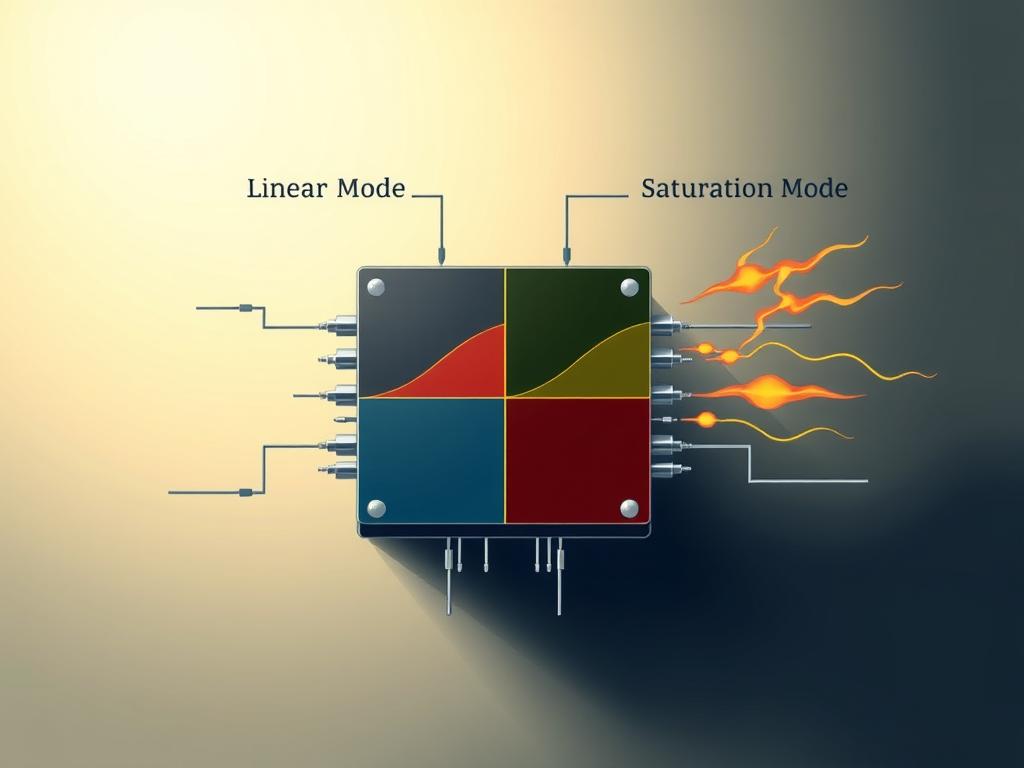MOSFETs are vital in 90% of modern electronic devices. They’re crucial for engineers and tech enthusiasts to understand. Let’s explore drain conduction and saturation modes, their differences, and uses.
MOSFETs are voltage-controlled devices with various operating modes. These modes include the triode (ohmic) region and saturation region. They determine how a MOSFET behaves in electronic circuits.
A MOSFET has four terminals: gate, drain, source, and body. N-channel MOSFETs are more common and easier to use. They have n-type drain and source regions, with a p-type body.
The triode and saturation regions affect current flow and voltage relationships. They also impact overall circuit performance. Understanding these concepts is key for power amplifiers and switching applications.
We’ll dive into MOSFET operating regions, from drain conduction basics to saturation mode details. This knowledge will help you optimize your electronic designs effectively.
Understanding Drain Conduction in Transistors
Drain conduction is vital for transistor operation, especially in MOSFETs. It happens when specific voltage conditions are met. This allows current to flow between the drain and source terminals.
Let’s explore the key aspects of drain conduction. We’ll also look at its importance in electronic circuits.
Definition and Importance
Drain conduction is the current flow in a transistor’s channel. It occurs when gate-to-source voltage exceeds the threshold voltage. This process is key to the Linear Mode of MOSFET operation.
Understanding drain conduction is crucial for designing efficient circuits. It’s used in various electronic applications, including amplifiers and switches.
Key Characteristics
In drain conduction, the transistor acts like a voltage-controlled resistor. Current flow depends on electron density in the channel. This is proportional to the difference between gate-to-source voltage and threshold voltage.
The relationship results in a linear current-voltage characteristic curve.
| Characteristic | Description |
|---|---|
| Conductance | Proportional to gate overdrive |
| Current | Proportional to vGS – Vt and vDS |
| Channel behavior | Acts as a voltage-controlled resistor |
Practical Examples
Drain conduction has many applications in electronic circuits. It’s used to create voltage-controlled resistors in analog amplifiers. The Active Mode in these devices relies on precise drain conduction control.
Channel Length Modulation is another important factor. It affects the transistor’s behavior in saturation.
The image shows drain conduction in a MOSFET. It displays current flow through the channel when voltages are applied. This visual helps engineers understand the physical processes in transistor operation.
What is Saturation Mode?
Saturation mode is a key operating state for power MOSFETs. It happens when the drain-source voltage surpasses the gate-source and threshold voltage difference. This mode is vital for linear voltage regulation and audio amplification.
Definition and Overview
In saturation mode, the MOSFET channel is pinched off at the drain end. This causes a steady current flow, even as drain-source voltage increases. The saturation current depends on Pinch-off and Velocity Saturation factors.
Conditions for Saturation
Two main conditions must be met for a MOSFET to enter saturation mode:
- The gate-source voltage (Vgs) must be greater than the threshold voltage (Vth)
- The drain-source voltage (Vds) must be equal to or greater than Vgs – Vth
High-Field Effects become important in this mode. They impact the device’s performance and efficiency.
Real-World Applications
Saturation mode is used in many practical applications:
| Application | Description |
|---|---|
| Digital Logic Circuits | Used as switches in digital systems |
| Analog Amplifiers | Provides stable gain for signal amplification |
| Current Sources | Delivers constant current for various circuits |
| Linear DC Motor Control | Enables precise speed control in motors |
Knowing saturation mode is crucial for engineers working with MOSFETs. It helps optimize device use and circuit design. This knowledge balances performance and power efficiency in electronic applications.
The Differences Between Drain Conduction and Saturation Modes
Drain conduction and saturation modes are vital operating states in MOSFETs. These modes affect device behavior and circuit performance. Knowing their differences is crucial for using transistors effectively.
Electrical Characteristics Comparison
Drain conduction, or the Triode Region, depends on gate-source (vGS) and drain-source (vDS) voltages. It shows a linear current-voltage relationship.
In saturation mode, drain current mainly relies on vGS. It shows little dependence on vDS.
| Mode | Current Dependency | Behavior |
|---|---|---|
| Drain Conduction (Triode) | vGS and vDS | Linear i-v relationship |
| Saturation | Primarily vGS | Constant current with increasing vDS |
Impacts on Circuit Design
These modes greatly influence circuit design. In the Ohmic Region, MOSFETs act as voltage-controlled resistors, ideal for switching.
Saturation mode, with constant current, is perfect for amplification. Power MOSFETs in saturation can control loads over 2000W, showing high efficiency.
Frequency Response Considerations
Frequency response differs between modes due to capacitances and transconductance. The Triode Region usually offers better high-frequency performance.
Channel Length Modulation, more noticeable in saturation, can affect frequency response. It alters the effective channel length, important for high-speed circuits or amplifiers.
“The structure with a p-type body is the basis of the n-type MOSFET, necessitating the addition of n-type source and drain regions.”
Grasping these differences helps engineers optimize MOSFET performance for specific uses. They can balance switching speed, power handling, and amplification needs.
Applications of Drain Conduction in Industry
Drain conduction is key in many industrial uses. It’s vital for power amplifiers, switching devices, and voltage-controlled resistors in analog circuits. Let’s look at how different sectors use drain conduction.
Power Amplifiers
Drain conduction is crucial for linear operation in power amplifiers. This mode allows precise control of signal amplification. It’s perfect for audio and radio frequency uses.
Depletion-mode MOSFETs are very useful here due to their unique traits.
Switching Applications
In switching, drain conduction’s low on-resistance is vital. It ensures efficient power transfer and less heat. MOSFETs in the linear region can act as fast, low-power switches in digital circuits.
Comparisons to Other Modes
Drain conduction differs from saturation mode in key ways:
| Aspect | Drain Conduction (Linear Mode) | Saturation Mode |
|---|---|---|
| Power Dissipation | Lower in some switching applications | Higher in general |
| Voltage Gain | Lower in amplifiers | Higher in amplifiers |
| Control | Precise current control | Voltage-dependent current source |
The best mode depends on circuit needs. Analog circuits often use drain conduction’s linear traits for precise signal processing. Knowing these differences helps optimize circuit performance and efficiency.

The Role of Saturation Mode in Electronics
Saturation mode is vital in modern electronics. It affects circuit design and performance. This state of transistors, especially MOSFETs, is key for efficient electronic systems.
Amplification in Linear Circuits
In linear circuits, saturation mode achieves high voltage gain. MOSFETs in this mode act as current sources. They provide stable amplification for analog signal processing and audio amplifiers.
Use in Digital Electronics
Saturation mode is crucial in digital logic circuits. It ensures stable logic levels and fast switching. The high resistance during pinch-off allows efficient switching in digital applications.
Impact on Signal Integrity
Saturation mode affects signal integrity in analog and digital systems. It reduces distortion in analog circuits. In digital systems, it improves noise margins.
The constant current in saturation mode maintains signal quality. This feature is important across various electronic designs.
| Parameter | Linear Mode | Saturation Mode |
|---|---|---|
| Current Behavior | Varies with voltage | Constant (current source) |
| Voltage Gain | Low | High |
| Application | Resistors, current sensors | Amplifiers, digital logic |
Engineers must grasp saturation mode for efficient electronic systems. It’s used in simple amplifiers and complex digital circuits. This shows its versatility in modern electronics.
Common FAQs About Drain Conduction and Saturation Modes
MOSFET operating regions are vital for circuit design and performance. Let’s explore some common questions about drain conduction and saturation modes.
What are the advantages of each mode?
Drain conduction mode offers linear behavior and low on-resistance. It’s ideal for efficient switches and low-distortion analog circuits.
Saturation mode provides high output impedance and voltage gain. This makes it perfect for high-gain amplifiers and digital logic applications.

How to switch between modes?
To switch modes, adjust the gate-source voltage (VGS) and drain-source voltage (VDS). The threshold voltage is key in this transition.
When to choose one mode over the other?
The choice depends on specific circuit needs:
- Use drain conduction for low-distortion analog circuits and efficient switches
- Opt for saturation in high-gain amplifiers and digital logic applications
Mastering both modes optimizes MOSFET circuit performance. Consider input impedance, noise levels, and power consumption when choosing a mode.
“Understanding MOSFET operating regions is the key to unlocking their full potential in electronic circuits.”
Conclusion: Choosing the Right Mode for Your Application
Understanding drain conduction and saturation modes is vital for effective MOSFET design and circuit optimization. Both modes are crucial in modern electronics. Each has unique characteristics and applications.
Summary of Key Points
Drain conduction and saturation modes have different electrical characteristics. They also impact circuit performance differently. Drain conduction suits switching applications and power amplifiers.
Saturation mode excels in linear amplification and digital electronics. Choosing between these modes affects power efficiency, linearity, and frequency response.
Recommendations for Engineers
Engineers should weigh factors like power dissipation and signal integrity when picking an operating mode. Drain conduction might work better for high-speed switching. Saturation mode could be ideal for precise amplification.
Balance performance and power consumption for the best circuit optimization. Consider your application’s specific needs when making your choice.
Future Trends in Transistor Applications
The transistor field is set for exciting changes. New MOSFET structures and materials will boost performance and efficiency. We’ll see innovative techniques for IoT devices and AI accelerators.
These developments will shape electronic design’s future. They’ll meet growing demands for powerful, energy-efficient devices.


